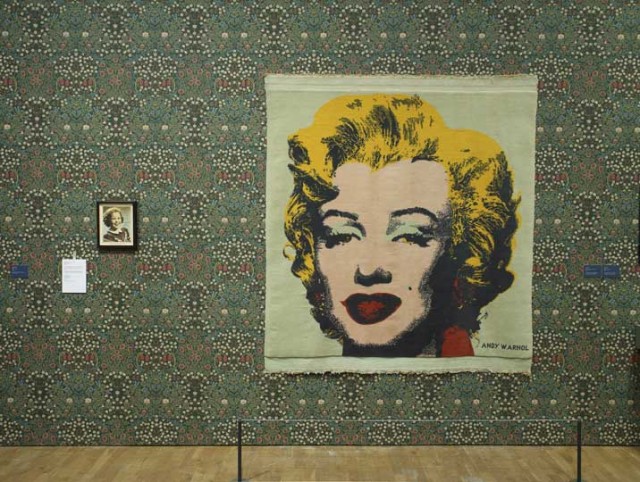Love Is Enough: William Morris & Andy Warhol — Reviewed
Visually overwhelming, disjointed and contrived: Laura Harris gets to grips with Jeremy Deller’s homage to the giants of printing at Modern Art Oxford…
Anyone who has been following Jeremy Deller’s work will already be familiar with his admiration for British society – its people, icons, folklore and political history — including arts and crafts pioneer William Morris. You may not know that Deller once spent a summer hanging out at Warhol’s Factory and rubbing shoulders with the man himself. Warhol and Morris might not be two artists you might think of side by side – one a signed-up socialist, one a celebrity-worshipping socialite – but Deller’s new exhibition is an attempt to align these two seemingly divergent artists.
On first impressions, Love is Enough at Modern Art Oxford is visually overwhelming. Never one to stick to exhibition clichés, Deller shuns the ubiquitous White Cube model, plastering walls with luscious Morris wallpapers, against which Warhol’s iconic images juxtapose interestingly, if not to say uncomfortably. The first exhibit, Holy Grail, is a colossal tapestry by Morris and frequent collaborator Edward Burne-Jones, which introduces the theme of Camelot. Deller riffs on this theme, conjuring up Warhol’s images of Jackie O and Kennedy, recalling the ‘Camelot’ of JFK’s inner circle. And so begins the contrived links between the two artists.
While there are a few very striking pieces of art on display, such as Holy Grail and Warhol’s Mao (which is surprisingly painterly, compared to his typical screenprints), this exhibition is largely one of ephemera. Warhol’s autograph collection leads onto an original Morris woodblock. Mao is displayed above a vitrine of Morris’ socialist writings (the politics of this curating seems a little confused). Morris’ incredible print of Chaucer’s works is watched over by photos of Warhol surrounded by Brillo Boxes. If this all seems a little disjointed, that’s because it is.
The last room centres on the floral aspects of both artists work. Morris’ floral prints, it seems to suggest, anticipate Warhol’s Flower Paintings. Such a comparison, however, falls a little flat. Lots of people draw flowers, after all. In fact, I suspect most people have drawn a flower at some point in their lives. Does this imply an aesthetic link between the two artists’ work? It seems a stretch.

The comparison of Morris and Warhol never really gets off the ground. It is true, of course, that both believed in collaboration; both drew flowers; both can tenuously be linked to the theme of Camelot; both wrote stuff. But none of these parallels really manage to get any convincing traction in the exhibition beyond the biographical.
A key tenet of the comparison seems to be that both artists believed that the ability to mass produce their images was central to their work. However, to suggest that this is borne of a similarity of temperament seems to me to be a profound misreading, which is surprising from a curator who usually offers such nuanced insights. For Morris, the reproducibility of his work was to ensure that the craft could retain a human touch to counteract the contemporary mechanisation of the workforce. Warhol, however, seemed to be to be celebrating the rise of mass production on a scale that would have mortified Morris; where is the human touch, the craft and useful labour, in aisle after aisle of identi-kit Brillo Pads? Here are two artists with polarised views on the virtue of mechanisation.
Tenuous though the curatorial gesture may be, the exhibition is well worth a visit; although I may suggest you treat it as two narratives, rather than getting bogged down in the comparisons. It’s interesting to notice that even the essays that accompany the show do not attempt to draw comparisons, but rather focus on one or other of the artists. This is the best approach, and treated as such I left with an increased adoration of Morris, and at least I don’t like Warhol any less.
The highlight of the show is certainly the reading room, which I would allow a long time to sit in and flick through the copies of Warhol’s, but mainly Morris’, writing. It would seem, sadly, that Jeremy Deller’s love of Warhol and Morris is not quite enough to make a convincing show.
Laura Harris
See Love Is Enough: William Morris & Andy Warhol at Modern Art Oxford until 8 March 2015 — free entry
Open Tuesday-Saturday 11am-6pm, and Sunday 12pm-5pm. Modern Art Oxford will be closed on Christmas Day and Boxing Day





